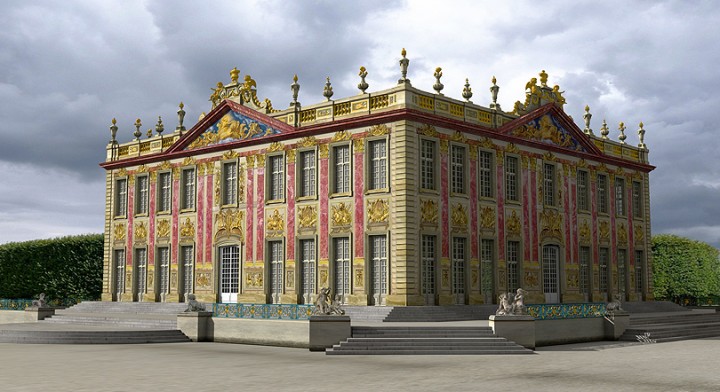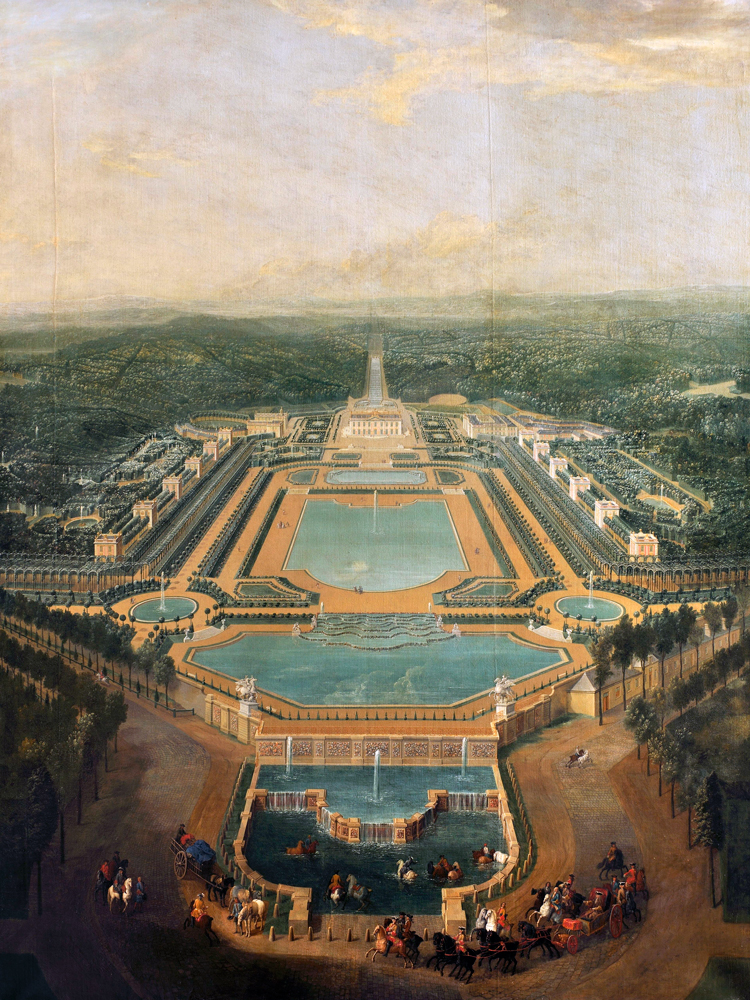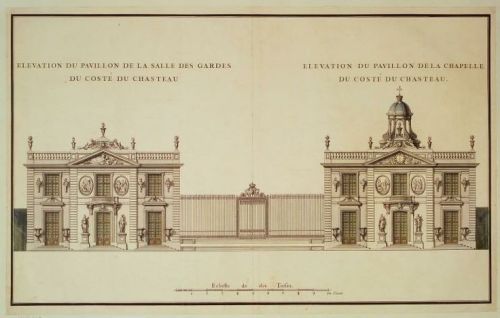As Versailles grew in size so did the number of inhabitants. The king sought a retreat where he could indulge in the small pleasures of gambling and hosting minor parties. The key was size; Marly was only meant to be a small château to force the number of invited guests down. The king had demanded that the chosen location must have a good view and be surrounded by forest rich on game. The chosen placed lay 7 km north-west of Versailles; a distance comfortable enough to be easily made in a day.
Ironically, the construction of Marly began already in 1679 - before the court had moved to Versailles. Jules Hardouin-Mansart and Charles Le Brun collaborated with the design. The king's personal pavilion was decorated with references to Apollo in his sun-chariot.
 |
| Recontruction of the king's pavilion |
By 1684 the construction was finished. In June of that year Louis XIV brought his nearest relations to the opening of the hydraulics. That in itself had been a feat to accomplish. Marly was located on somewhat of a slope which meant that water was not naturally there. Consequently, it had to be brought there by the inventions of man. The result was the so-called Marly machine. Fourteen large paddlewheel were powered by the Seine and provided water for Versailles and Marly. However, it was only possible to supply one at a time. Therefore, it depended on where the happened to be staying. When he was at Versailles the fountains there would be flowing; if he was at Marly the fountains of Versailles would lay dry.
It was not until 1686 that the king could inhabit Marly for the first time. From then on Louis XIV would continue to add to his new retreat. Two years later a small stable was added for the king's horses. This meant that the horses no longer had to be brought from Versailles. Wide paths were added to the hunting grounds for ladies or the elderly to follow the hunt. In 1697-98 the "river" was finished which added a touch of water so important to Baroque design. This "river" led to a remarkably large waterfall which fell over marble decorations.
 |
| Marly - notice the king's pavilion to the centre |
The design itself was something quite new. The king and his nearest family would inhabit the largest pavilion which was - naturally - located in the centre. Immediately before and behind the king's pavilion lay large beds of water. Spread out in a straight line were smaller pavilions named after Greek gods or ideals. These were reserved for the privileged few who were invited by the king.
Although Marly was meant to be a pleasure retreat it was still a royal residence. Four pavilions were erected in the vicinity of the king's pavilion. The housed the royal guards. servants and a chapel. One of these were converted in 1688 to a bath for the guests.
 |
| View from the front |
The pavilions must have been a sight in themselves. They were richly decorated with coloured polychrome which formed trompe-l'oeils. In the years following 1686 the pavilions saw their surroundings embellished. Before their "backyards" had been plain grass banks; these were transformed into groves and parterres with fountains. It can only be imagined that the courtiers who were lucky enough to go appreciated it.
Each pavilion was connected to the next via a trellis arch and flanked by yew trees. Actually, yew trees were often used for the gardens of Marly. So were orange trees; a favourite of Louis XIV.
Towards the end of his life, Louis XIV would spend more and more time at Marly. His visits there varied between an afternoon and little over a week. When the queen died her rooms were given to the Grand Dauphin. Likewise, the members of the royal family had small apartments there.
 |
| Chapel (right) and guards' house (left) |
During Louis XIV's reign it was considered an extreme privilege to be included on the guest-list to Marly. Courtiers would announce their interest in going by simply asking "Sire, Marly?". Eventually, this became a nuisance to the king who instead had a list of the invitees posted. This tradition of asking continued with both Louis XV and Louis XVI. However, in 1746 the admittance was far less strict than earlier. This year it became the norm for anyone who asked to be received.
Sadly, neither the Regent nor Louis XV was particularly excited by Marly. The place was seldom visited after 1715. In 1728 the "river" was removed and converted into a field. Still, it was all but deserted.
 |
| Grounds of Marly |
Louis XVI used Marly as well but not nearly as frequently as Louis XIV had. The interest in Marly had become considerably less enthusiastic since other châteaux had been build: Choisy, Bellevue and La Muette were all more in the modern style. The last royal visit was in June 1789.
 |
| Pavilion of Thétys |
The château was demolished in 1806 after having been used as a factory which failed. Nothing remains today of the once so beloved château of Louis XIV. Only parts of the park and the so-called drinking pool (for the horses) are still intact.

No comments:
Post a Comment